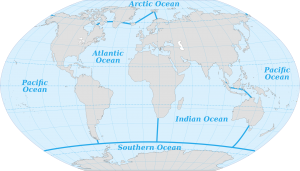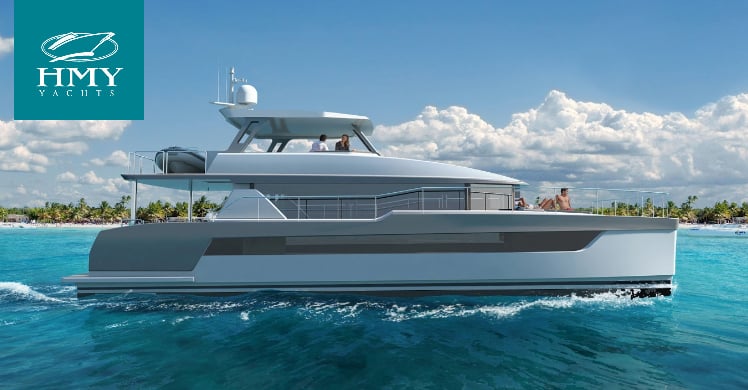All About the World Ocean

There is one global ocean making up 71% of Earth’s surface, but the global ocean is divided into distinct regions that have evolved over time based on cultural, geographical, historical, and scientific factors. These distinct regions are called ocean basins. Ocean basins are saucer-like depressions of the seabed that vary in size from relatively minor to vast structural divisions of the ocean. The deepest ocean basins are up to 2 to 3 miles deep and stretch from the outer edges of a continent to the ridges in the middle of the ocean, but the average depth is approximately 16,000 feet. In the past, there were four named oceans: the Atlantic, Arctic, Indian, and Pacific oceans. However, now most countries recognize that there is a fifth known as the Southern Ocean.
Pacific Ocean Basin
You can find the Pacific Ocean west of North and South America and to the east of Asia and Australia. The Drake Passage, a stretch of water around the southern tip of South America, connects the Pacific and Atlantic oceans. The Pacific Ocean is the largest and deepest of all of the world’s oceans, and because of that depth and length, it contains more than half of the world’s free-flowing water.
The Pacific Ocean is also the oldest of the existing basins, with some rocks discovered in its waters having been dated at around 200 million years old, and most of the important features of this ocean basin are associated with plate tectonics. Plate tectonics is the principle that describes how Earth’s outer layer is made up of solid rock pieces called plates that move over the molten material below. When two plates collide, the pressure can force the plates to fold up into mountain ranges or down into trenches at subduction zones. The stresses around these subduction zones are why the Pacific basin is responsible for many earthquakes and volcanoes, which is why the outside of this basin is also called the “Ring of Fire.”
Atlantic Ocean Basin
The Atlantic Ocean is the second-largest, but it’s first when it comes to travel and how much it’s been studied thanks to how important ship traffic between Europe and North America is. With this intense study, we’ve learned that the Atlantic began to form during the Jurassic period 150 million years ago after a rift opened up and separated South America and Africa. The movement of continental plates in the Atlantic basin has created the Mid-Atlantic Ridge, which divides the eastern and western ocean floors into a series of basins called the abyssal plains. This ridge is more than 5,000 meters deep, but there’s a break in it at the equator that gives the deep ocean a gap to flow through. This gap influences the currents and temperatures of the Atlantic Ocean.
Indian Ocean Basin
The Indian Ocean is the third-largest ocean and is bounded by Africa to the west, Asia to the north, Australia to the east, and the Southern Ocean to the south. There is no natural boundary that separates it from the Atlantic Ocean, but scientists generally draw the line between them at Cape Agulhas, South Africa. This basin is also divided in half by the Mid-Indian Ridge.
Southern Ocean
In 2000, the International Hydrographic Organization named the Southern Ocean as the world’s fifth ocean. It is not a true ocean basin, but it is still considered the fourth-largest ocean on the planet. It completely encircles Antarctica and stretches to the 60th parallel south, the limit of the Antarctic Treaty.
Arctic Ocean Basin
The Arctic Ocean is the smallest ocean basin on Earth. It extends south from the North Pole to the shores of Europe, Asia, and North America, and its total surface area is about 5.4 million square miles. Approximately a third of this ocean covers continental shelves; because of this, the average depth of the Arctic Ocean is only about 4,900 feet, and the deepest point is 17,880 feet.
Unlike the other oceans, the Arctic Ocean is covered with ice. Near the North Pole, the ice is permanent, but farther south, the ice can melt and move. Some of the ice forms “islands” that scientists have used as research bases.
- Ocean Basins and Continents: This page offers maps, activities, and descriptions of the different ocean basins and how they’re all connected.
- Ocean Currents and Climate: USC put together this easy-to-understand explanation of the different types of ocean currents and how the climate and currents affect the different ocean basins.
- Why Are There Ocean Basins, Continents, and Mountains? The American Museum of Natural History discusses how ocean basins came to reshape the surface of Earth and offers exhibits from their museum that you can walk through from the comfort of your own home to learn more.
- Ocean Geography: Learn about the global ocean and the various smaller seas that cover most of Earth.
- Ocean Basins: Definition, Formation, Features, and Types: This page offers a video lesson on ocean basins and how they’re formed.
- Oceans and Seas and the Water Cycle: Read about the water cycle and how Earth’s oceans and seas are affected by it as the largest reservoirs of water on Earth.
- Mapping the Oceans: This article examines the importance of mapping the seafloor and learning more about ocean currents.
- Ocean Floor Features: The National Oceanic and Atmospheric Administration offers this detailed article about the different ocean floor features that have been discovered and how they are formed.
- World Landforms: Ocean Basin: This page looks at the definition of oceanic basins as well as facts, common questions, and examples.
- Oceans for Kids: Find out about the different oceans of the world and read a brief description of each ocean on this page.
- Ocean Trenches: This article covers ocean trenches, how they are formed, where they are located, and what the conditions inside the trenches are like.
- Exploring the Ocean With Kids: PBS has compiled information about different zoos and aquariums to visit, webcams of ocean life to watch, and books about sea creatures to pique students’ interest in the ocean.
- Oceans of the World: This article talks about the five different oceans in the world, how oceans affect the climate, and facts about ocean pollution.
- The World’s Oceans: Find a brief overview of all five of the oceans on this page.
- The Pacific Ocean: Read more about the world’s largest ocean with this article.
- Pacific Ocean Facts: See lots of facts and figures about the Pacific Ocean in the CIA’s world database.
- Indian Ocean: This page gives a brief overview of the Indian Ocean and has a photo of the ocean that you can click on to learn more facts.
- How Big Is the Arctic Ocean? The World Wildlife Fund has a list of nine fun facts about the Arctic Ocean here.
- Quick Facts on Arctic Sea Ice: The National Snow & Ice Data Center has compiled a list of quick facts about arctic sea ice, why it’s important, and how scientists are monitoring it.
- Southern Ocean Observing System: This page covers why scientists are monitoring the world’s newest ocean. It’s rapidly changing, and its climate affects the climate of the oceans around it as well as sea life.
